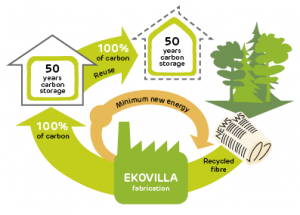
Ecofriendly
Ekovilla is mainly made of recycled wood fiber, for example, using the very newspaper you recently read. When you take your newspaper to the collection box, to be further transported to our factory, you make an easy and yet important ecological daily choice. We sort the papers brought to the factory defiber it into the warm and green Ekovilla.
When you choose Ekovilla for building or renovating, you insulate your home in a carbon neutral way. In other words: manufacturing our insulation does not produce more carbon than the wood-based raw material is able to bind.
Ekovilla can be further recycled in several ways. If the building is demolished and removed, our products can be reused as they are for thermal insulation. At the end of its life cycle our insulation can be used for energy among other fuels, or it can be diluted and used for soil improvement. During its life cycle the carbon handprint of Ekovilla can even exceed its carbon footprint. Circular economy at its best!
Check the more detailed properties of our carbon-friendly products and learn more about the Ekovilla HELP-cycle below

Our carbon neutral Ekovilla HELP consists of four parts: Handprint of carbon, Energy efficiency, Locality and logistics and Persistent storage and preservation
H – Handprint rather than footprint
 When striving for carbon neutrality in construction, the beginning always lies in production. When building, the primary aim is to find building materials and structural solutions with the smallest possible carbon footprint. Wooden building materials have smaller carbon footprint compared to other typical materials such as steel or concrete. Another solution is to choose products that have the greatest possible climate benefit, i.e. the largest possible carbon handprint.
When striving for carbon neutrality in construction, the beginning always lies in production. When building, the primary aim is to find building materials and structural solutions with the smallest possible carbon footprint. Wooden building materials have smaller carbon footprint compared to other typical materials such as steel or concrete. Another solution is to choose products that have the greatest possible climate benefit, i.e. the largest possible carbon handprint.
Products can have both, small carbon footprint and large handprint, at the same time. The carbon footprint of wood-based products is so significant that it allows the climate load of other products to be reduced, and in some cases even reset.
By choosing Ekovilla’s natural material, recycled raw material product, the carbon good it creates will increase your home’s carbon footprint.
Energy efficiency 
Buildings are estimated to be the cause for one third of Finland’s greenhouse gas emissions, and the largest part of this is related to energy consumption during use. The share of emissions has steadily decreased with the emerge of new, more energy-efficient buildings and the increase of more sustainable heating systems.
However, much can be still done. With ecological choices and well thought design, the real energy efficiency of a building can be further improved. Improving the air-tightness of buildings’ insulation cladding and preventing convection (air movement inside the insulation) are key factors in achieving better, near-zero energy efficiency.
Ekovilla is effective thermal insulation and when the installing instructions are followed correctly, it will become the air-tightness below the target of 0.4. The fluffy fiber of eco-wool keeps the insulating air effectively in place inside the insulating layer.
Emissions from actual energy consumption during operation remain so low that Ekovilla’s large carbon stock can compensate for it even for the entire life cycle of the building.
Locality and Logistics
 Transportation of construction products during manufacturing, installation and dismantling is part of the construction emissions. The longer the distance, and the more complex logistics chains, the larger the carbon footprint.
Transportation of construction products during manufacturing, installation and dismantling is part of the construction emissions. The longer the distance, and the more complex logistics chains, the larger the carbon footprint.
By using Ekovilla’s products in construction, emissions from transportation also remain low at all stages. The raw material used by Ekovilla, pure selected recycled paper, is collected in the vicinity of insulation factories in cooperation with local administrators. Our three plants are located around the country and are located as close as possible to construction sites, thus reducing emissions from installation runs.
In addition to this, we invest in logistical optimization: Good planning and guidance aim at full loads and all site installations are handled in one go, further reducing runs. The same optimization also applies to the demolition phase, where the insulation is sucked up and reprocessed for the plant closest to the site.

Persistent storage and preservation 
In carbon-neutral construction, understanding the value of a carbon stock is essential. The longer the carbon of the product is in the building, the longer it is out of the atmosphere. Therefore, the longevity of structures must be already considered in design. Properly made wooden buildings have lasted for hundreds of years, and the most durable wood structures are always based on the breathability of the structure.
These structures are the same, where the carbon is stored for the longest time. Ekovilla, and its breathable dynamic structures, allow moisture to find a natural balance through the structure without causing damage, enabling a carbon storage up to 50 years.*
Building carbon neutrally, when done correctly, is structurally problem-free as well as long-lasting. Even after the demolition of a fully served building, the wood fiber insulation may be 100% recyclable for a new use, for a new 50 years or even another hundred years.

*50 years is an estimate for an average life of a house. However, it is possible for the insulation to last much longer than that.
-
What does carbon neutral mean?
In general, carbon neutrality refers to an activity which produces only as much CO2 emissions as it is able to sequester. The opposite of this is an activity which causes emissions. In that case we are talking about the carbon footprint.
Thus, carbon neutral construction means a construction-related activity which produces only as much CO2 emissions as it is able to sequester. Sequestering may be related to the manufacturing or the usage stage.
Ekovilla products sequester carbon dioxide during both stages: The products are manufactured with extremely low emissions and the net emissions of the process are zero. Wood fiber also sequesters carbon dioxide throughout its entire life cycle (acting as a carbon sink), which means that a well-kept home may sequester carbon dioxide even for fifty years.
Ministry of the Environment as well as many construction specialists emphasize the importance of low-carbon construction. More information on terminology can be found, for example, on Sitra’s page.
The life cycle study, verified in the beginning of 2020 shows that Ekovilla has reached the carbon neutrality of its products!
-
How was carbon neutrality studied?
Ekovilla’s blown wool and the Ekovilla slab have undergone a Life Cycle Assessment (LCA) in Finland’s Technology Research Center (VTT Oy).
The studies are currently in the documentation phase and will appear both in the RTS database and to the Materials section of our web page.